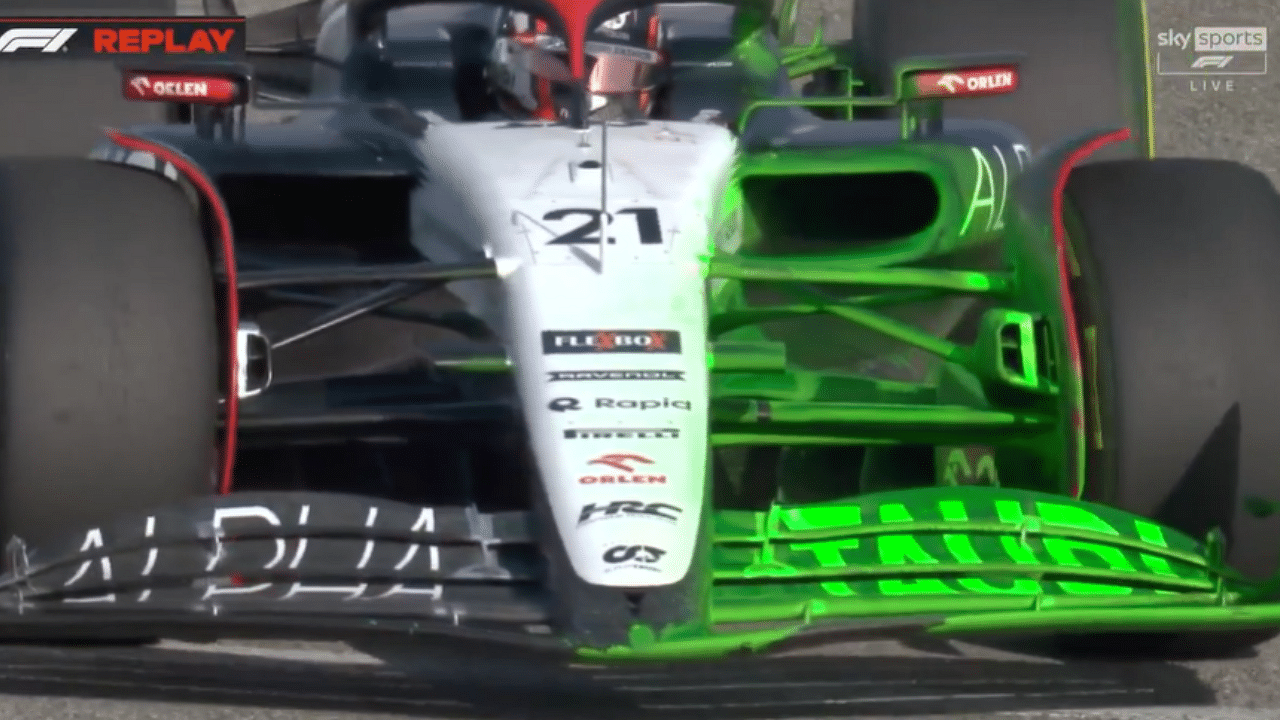Every year, F1 continues to push the limits of modern technology. The advancements they make in this field are beyond extraordinary, and the engineers work hard to do the best for their teams. However, the most intricate look at the technological aspects of the sport is seen during the pre-season testing sessions. One such phenomenon is that fans wonder about the fluorescent green stuff on some of the cars. What are these colors? Why are they added to the cars?
That green ‘stuff’ or paint is known as flow-visualization paint or the ‘flow-vis’ as it is known among the teams. The color that looks like paint, is not actually paint. Instead, it is an oily substance that is mixed with fluorescent powder. They are only sprayed on parts of the car, that the team members will keep an eye out for.
What does Flow-vis do for aerodynamics?
To put things simply, the Flow-vis helps the teams keep track of the aerodynamics of the car. Right before going out on the track, they are sprayed on the car. Because F1 cars move at different speeds, and move in different directions all over the circuit, the paint moves.
These movements result in patterns on the car’s chassis, which the engineers then investigate. Upon investigation, the airflow is understood in a much better way. Imbalance through the corners, drag in a straight line and other aspects are noted.
FLOW-VIZ all over the AlphaTauri in the afternoon session #F1 pic.twitter.com/UlveZoHrzq
— Junaid #JB17 (@JunaidSamodien_) February 23, 2023
In simple terms, the flow-vis is like a wind tunnel for the aerodynamicists. The only difference is that it is out on track and the wind is not being artificially created. The engineers even compare their findings from the wind tunnel to the data gathered through flow-vis.
On the other hand, the flow-vis patterns are visible to the entire world during testing, so rivals on the paddock can certainly catch a glimpse. If there are geniuses like Adrian Newey out on the track, maybe it could be risky to use flow-vis.
Can other F1 teams steal aerodynamic inputs?
Well, it is risky. For example, when a team runs their car on flow-vis and gets it back to the garage, the competitors might get an opportunity to click a picture of the car or the patterns made through the airflow.
Painting the town
‘Flow-vis’ is one of the many important elements to #F1 Testing ⬇️
— Formula 1 (@F1) February 21, 2020
It is a dream of any competitor to sneak a peek at what their opponent is up to. So if they are successful in capturing an image of the car and understand the flow structure, they can use it for their own benefit. Often, to prevent this, teams use covers to hide the car from the cameras and rival eyes as soon as it has entered the pits.
When was flow-viz first used?
While flow-viz was first used on an F1 track in 2010, F1 teams have been using it for their wind-tunnel use for years. McLaren was the first team to be in the public eye during the pre-season test in Jerez.
As discussed earlier, teams are concerned about their aero data reaching other teams if they use viz-flow in an open testing place. But in the following year, other teams like Renault, Red Bull, Lotus, and Ferrari started to use it on the track.
Nowadays, the F1 landscape is very different than what it was 15 years ago. Track testing is hardly as frequent as it was back then. These days, apart from an odd private testing, teams rely on three-day pre-season testing to gather their data from track. Carlos Sainz, who has to adapt to Williams’ Mercedes engine, claims it’s not enough to get settled.
“Normally from my experience, that adaptation process – with only three days of [pre-season] testing, which is one and a half [days] per driver – my experience tells me it takes around half a year to really understand all the tricks and the little details on the car,” said Sainz.
Although teams get identical data from several runs on the simulator, still it cannot give the same feeling to drivers as a real car could give on the tarmac. To give a benefit of the doubt to the F1 teams, the hectic schedule and cost cap budget can’t allow teams to have numerous private tests.





